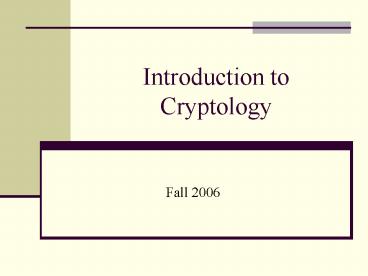Introduction to Cryptology - PowerPoint PPT Presentation
Title:
Introduction to Cryptology
Description:
... comes from the Greek words. Kryptos, meaning hidden, Graphen, meaning ... The word cipher originates from the Hebrew word 'Saphar,' meaning 'to number. ... – PowerPoint PPT presentation
Number of Views:60
Avg rating:3.0/5.0
Title: Introduction to Cryptology
1
Introduction to Cryptology
- Fall 2006
2
Definitions
- Digital encryption techniques are used to protect
data in two ways to maintain privacy and to
prove integrity 1 - Cryptography comes from the Greek words
- Kryptos, meaning hidden,
- Graphen, meaning to write.
- Cryptography is the art of communicating
confidentially through an insecure channel - Cryptanalysis is the art of deciphering those
communications when one is not the legitimate
receiver. - Cryptology is the union of these two domains.
- Cryptology is actually the study of codes and
ciphers.
3
Definitions
- Plaintext the original message that is to be
changed into a secret form - Cipher, Cryptosystem, Encryption Method is a
procedure for converting the plaintext message
into encrypted message ciphertext - The word cipher originates from the Hebrew word
"Saphar," meaning "to number." - Decryption - the process that conducted by the
intended receiver to recover original message
(plaintext) from the encrypted message
(ciphertext) - Key - keeps the message secret
4
Encryption-Decryption
Plaintext
Ciphertext
Encryption key
Encryption Method
Ciphertext
Plaintext
Decryption Key
Decryption method
5
Symmetric and Asymmetric Ciphers
- Symmetric Cipher knowledge of encryption key is
equivalent to knowledge of the decryption key, or
the same key is used for encryption and
decryption. - Asymmetric Cipher (Public-Key Cryptosystem) the
knowledge of encryption key give little
information about the decryption key and vice
versa
6
Early History of Cryptology
- Polybius Checkboard
- 205 123 B.C.
- Plaintext POLYBIUS produces the ciphertext
- 3534315412244543
1 2 3 4 5
1 A B C D E
2 F G H IJ K
3 L M N O P
4 Q R S T U
5 V W X Y Z
7
Julius Caesar Cipher
- Caesar enciphered messages by replacing each
letter by the third letter after that one - A ? D, B ? E, C ? F, D ? G, Z ? C
- Plaintext ET TU, BRUTE?'' becomes the ciphertext
HW WX, EUXWH?'' - Ciphertext may be deciphered by replacing each
letter by the third previous letter. - We think of each letter as corresponding to a
number from 0 to 25 - To encipher, we map numbers according to
- C ? ( P 3 )(mod 26)
- To decipher, we map numbers according to
- P ? (C 3) (mod 26)































